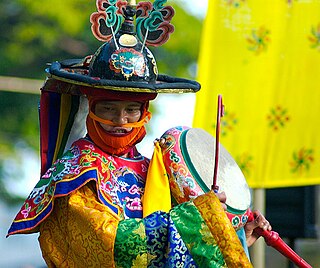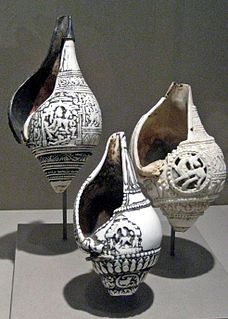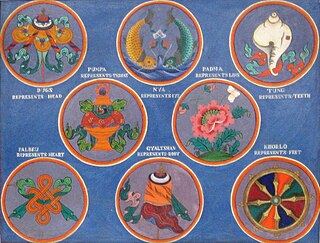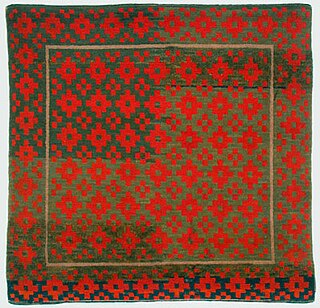 W
WTibet developed a distinct culture due to its geographic and climatic conditions. While influenced by neighboring cultures from China, India, and Nepal, the Himalayan region's remoteness and inaccessibility have preserved distinct local influences, and stimulated the development of its distinct culture.
 W
WThe Central Institute of Higher Tibetan Studies, formerly called Central University for Tibetan Studies (CUTS), is a Deemed University founded in Sarnath, Varanasi, India, in 1967, as an autonomous organisation under Union Ministry of Culture. The CIHTS was founded by Pt. Jawahar Lal Nehru in consultation with Tenzin Gyatso, the Dalai of Lama, with the aim of educating Tibetan youths in exile and Himalayan border students as well as with the aim of retranslating into Sanskrit and translating into Hindi and other modern Indian languages lost Indo-Buddhist Sanskrit texts that now exist only in Tibetan.
 W
WThe cham dance is a lively masked and costumed dance associated with some sects of Tibetan Buddhism and Buddhist festivals. The dance is accompanied by music played by monks using traditional Tibetan musical instruments. The dances often offer moral instruction relating to karuṇā (compassion) for sentient beings and are held to bring merit to all who perceive them.
 W
WA chuckmuck is a belt-hung leather and metal decorated tinder pouch with an attached thin long striking plate, found across North Asia and China to Japan from at least the 17th century. Chuckmucks form a well marked group within flint-and-steel types of fire-lighting kit, still used as ethnic jewellery amongst Tibetans (mechag) and Mongolians (kete). This large distinctive style of a worldwide daily utensil was noted in Victorian British India and the 1880s Anglo-Indian word chuckmuck was adopted into specialist English by the early 20th. century.
 W
WDzi bead is a type of stone bead of uncertain origin worn as part of a necklace and sometimes as a bracelet. In several Central Asian cultures, including that of Tibet, the bead is considered to provide positive spiritual benefit. These beads are generally prized as protective amulets and are sometimes ground into a powder to be used in traditional Tibetan medicine. Beads subject to this process have small "dig marks" where a portion of the bead has been scraped or ground away to be included in the medicine. Some dzi exhibit grinding and polishing of one or both ends, again the result of reduction for use in traditional Tibetan medicine or, in some cases, due to the bead's use as a burnishing tool in the application of gold leaf to thanka paintings or gilt bronze statuary.
 W
WThere is widespread belief in ghosts in Tibetan culture. Ghosts are explicitly recognized in the Tibetan Buddhist religion as they were in Indian Buddhism, occupying a distinct but overlapping world to the human one, and feature in many traditional legends. When a human dies, after a period of uncertainty they may enter the ghost world. A hungry ghost has a tiny throat and huge stomach, and so can never be satisfied. Ghosts may be killed with a ritual dagger or caught in a spirit trap and burnt, thus releasing them to be reborn. Ghosts may also be exorcised, and an annual festival is held throughout Tibet for this purpose.
 W
WThe use of historical money in Tibet started in ancient times, when Tibet had no coined currency of its own. Bartering was common, gold was a medium of exchange, and shell money and stone beads were used for very small purchases. A few coins from other countries were also occasionally in use.
 W
WLhamo, or Ache Lhamo, is a classical secular theatre of Tibet with music and dance that has been performed for centuries, whose nearest western equivalent is opera. Performances have a narrative and simple dialogue interspersed with comedy and satire; characters wear colorful masks. The core stories of these theatrical plays are drawn mostly from ancient Indian Buddhist folk tales, lives of important people and historical events from Tibetan civilization. However the ceremonial, dance and ritual spectacles strongly reflects the Tibetan Royal Dynastic period.
 W
WThe Lingkhor is a sacred path, the most common name of the outer pilgrim circumambulation path in Lhasa.
 W
WThe inaugural Miss Himalaya Pageant was held in Dharamshala, India, on 12–13 October 2012. The purpose of the annual event is "to bring women from the entire Himalayan region onto one platform to celebrate the beautiful cultures, people, and nature of the Himalayan region."
 W
WThe Mongolian and Tibetan Cultural Center is a cultural center in Da'an District, Taipei, Taiwan under the administration of the Ministry of Culture. It was previously under the Mongolian and Tibetan Affairs Commission of the Executive Yuan, which in 2017 had its duties absorbed into the Ministry of Culture and the Mainland Affairs Council's Department of Hong Kong, Macao, Inner Mongolia, and Tibet Affairs.
 W
WMonlam also known as The Great Prayer Festival, falls on 4th–11th day of the 1st Tibetan month in Tibetan Buddhism.
 W
WThe Nakhi or Nashi are an ethnic group inhabiting the foothills of the Himalayas in the northwestern part of Yunnan Province, as well as the southwestern part of Sichuan Province in China.
 W
WPha Trelgen Changchup Sempa is a mythical monkey-ancestor of the Tibetan people. With King Gesar and Avalokiteśvara, of whom he is an incarnation, he is one of the most important figures in Tibetan culture. Pha means "father", Trelgen "old monkey" and Changchup Sempa refers to the bodhisattva.
 W
WA Shankha has religious ritual importance in Hinduism. It is the shell of any suitable sea snail which had a hole made for the performer's embouchure.
 W
WSitting-in-the-bed is a major religious ceremony in Tibetan Buddhist temples. It is a necessary ceremony for the reincarnated person to formally succeed the living Buddha by the reincarnated soul boy and change the name during the inheritance process of the living Buddha.
 W
WSky burial is a funeral practice in which a human corpse is placed on a mountaintop to decompose while exposed to the elements or to be eaten by scavenging animals, especially carrion birds. It is a specific type of the general practice of excarnation. It is practiced in the Chinese provinces and autonomous regions of Tibet, Qinghai, Sichuan and Inner Mongolia, as well as in Mongolia, Bhutan and parts of India such as Sikkim and Zanskar. The locations of preparation and sky burial are understood in the Vajrayana Buddhist traditions as charnel grounds. Comparable practices are part of Zoroastrian burial practices where deceased are exposed to the elements and birds of prey on stone structures called Dakhma. Few such places remain operational today due to religious marginalisation, urbanisation and the decimation of vulture populations.
 W
WThe Snow Lion is a celestial animal of Tibet. It is the emblem of Tibet, representing the snowy mountain ranges and glaciers of Tibet, and may also symbolize power and strength, and fearlessness and joy, east and the earth element. It is one of the Four Dignities. It ranges over the mountains, and is commonly pictured as being white with a turquoise mane. In Journey to the West published in 1592, Snow Lion is depicted as one of Yōkais .
 W
WThokcha are tektites and meteorites which serve as amulets. Typically high in iron content, these are traditionally believed to contain a magical, protective power comparable to Tibetan dzi beads. Most thokcha are made of a copper alloy.
 W
WThe Tibet Museum is the official museum of the Central Tibetan Administration's Department of Information and International Relations and is located near the main temple of the 14th Dalai Lama, Tsuglag Khang, in the Dharamshala suburb of McLeod Ganj. The Tibet Museum aims to disseminate knowledge of Tibetan history and culture while raising awareness of the occupation of Tibet and the ongoing human rights abuses committed by China. Established in 1998, the Tibet Museum now has a collection comprising over 30,000 photographs, a traveling exhibition, and a permanent exhibition that documents the Tibetan journey into exile across the Himalayan ranges.
 W
WThe Tibet Museum is the official museum of the Tibet Autonomous Region of China in Lhasa. Inaugurated on October 5, 1999, it is the first large, modern museum in the Tibet Autonomous Region. It has a collection of more than 520,000 artifacts, including pottery, jade, and Buddha statues, attracting hundreds of thousands of visitors every year. It has a collection of around 1,000 artifacts permanently on display related to the cultural history of Tibet, from examples of Tibetan art to architectural design throughout history such as Tibetan doors and beams.
 W
WThe Tibet Museum is a museum dedicated to Tibetan culture in Sogyeok-dong, Jongno-gu, Seoul, South Korea.
 W
WTibetan incense is made in Tibet, Northern parts of Nepal, and Bhutan. Incense is an important representation of the Tibetan culture. These incenses have a characteristic "earthy" or herbal scent to them. Tibetan incenses can contain 30 or more ingredients. As with most Asian incense, Tibetan incense is not rolled around a bamboo stick, but is extruded into lengths or coils.
 W
WThe Ashtamangala is a sacred suite of Eight Auspicious Signs endemic to a number of religions such as Hinduism, Jainism, and Buddhism. The symbols or "symbolic attributes" are yidam and teaching tools. Not only do these attributes point to qualities of enlightened mindstream, but they are the investiture that ornaments these enlightened "qualities". Many cultural enumerations and variations of the Ashtamangala are extant.
 W
WPrayer Wheels are widely used in Tibet and areas where Tibetan culture is predominant.
 W
WTibetan rug making is an ancient, traditional craft. Tibetan rugs are traditionally made from Tibetan highland sheep's wool, called changpel. Tibetans use rugs for many purposes ranging from flooring to wall hanging to horse saddles, though the most common use is as a seating carpet. A typical sleeping carpet measuring around 3 ft × 5 ft is called a khaden.
 W
WLobsang Wangyal is a writer, social activist, photojournalist, and events producer, based in McLeod Ganj, Dharamshala, India. He has been a stringer reporter and photographer for Agence France-Presse for many years.